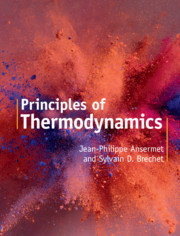4 - Thermodynamic Potentials
from Part I - Foundations
Published online by Cambridge University Press: 14 December 2018
Summary
As internal energy is a function of entropy, volume and number of moles, its differential is given by the Gibbs relation, and temperature, pressure and chemical potentials are defined as conjugate variables. Extensivity implies the Euler relation. The Gibbs-Duhem relation will find applications later, in the analysis of phase transitions. Legendre transformations are introduced, leading to the definition of the thermodynamic potentials: free energy, enthalpy and Gibbs free energy. When a system is coupled to a thermal reservoir or heat bath, its equlibrium is characterised by a minimum of the free energy; when it is a work reservoir, the enthalpy is minimum, and when it is a work and heat reservoir, the Gibbs free energy is minimum. Maxwell relations establish relationships between quantities that would not immediately be associated. The cyclic chain rule links together the derivatives of one property function with respect to two others. It is conveniently applied to analyse the Joule expansion and Joule-Thomson effect.
Keywords
- Type
- Chapter
- Information
- Principles of Thermodynamics , pp. 70 - 100Publisher: Cambridge University PressPrint publication year: 2019



